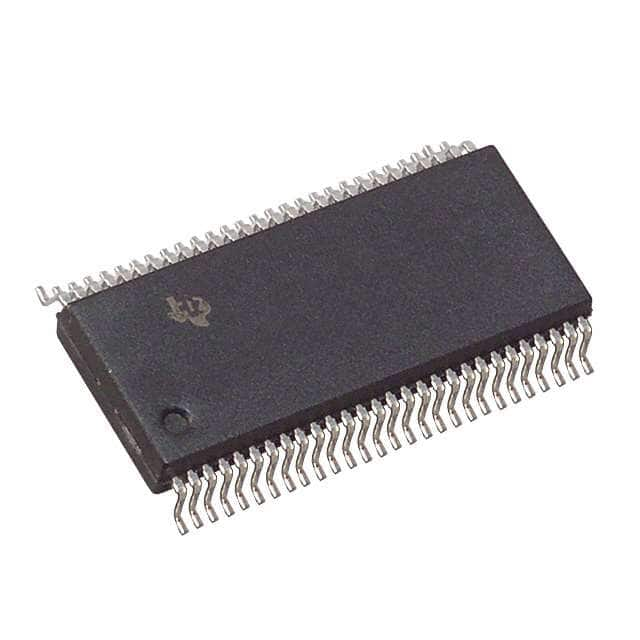SN74ABT162825DLR
Product Overview
- Category: Integrated Circuit (IC)
- Use: Data Buffer/Line Driver
- Characteristics: High-speed, low-power, 18-bit universal bus driver with 3-state outputs
- Package: 56-pin SSOP (Shrink Small Outline Package)
- Essence: Provides bidirectional buffering and line driving for a wide range of applications
- Packaging/Quantity: Tape and reel, 2500 units per reel
Specifications
- Supply Voltage Range: 4.5V to 5.5V
- Input Voltage Range: 0V to VCC
- Output Voltage Range: 0V to VCC
- Operating Temperature Range: -40°C to +85°C
- Output Drive Capability: ±24mA at 3.3V
- Propagation Delay: 2.8ns (typical)
Detailed Pin Configuration
The SN74ABT162825DLR has a total of 56 pins, which are assigned as follows:
- OE1 (Output Enable Input 1)
- A1-A18 (Data Inputs/Outputs)
- GND (Ground)
- B1-B18 (Data Inputs/Outputs)
- VCC (Supply Voltage)
- OE2 (Output Enable Input 2)
- Y1-Y18 (Data Outputs)
- NC (No Connection)
Please refer to the datasheet for a complete pin configuration diagram.
Functional Features
- Bidirectional data flow capability
- 3-state outputs for bus sharing
- Non-inverting outputs
- High-speed operation
- Low power consumption
- ESD protection on all inputs and outputs
Advantages and Disadvantages
Advantages: - High-speed operation allows for efficient data transfer - Low power consumption helps in reducing energy usage - ESD protection ensures reliability in harsh environments - 3-state outputs enable bus sharing, reducing the number of required components
Disadvantages: - Limited to 18-bit data buffering - Requires external control signals for proper operation
Working Principles
The SN74ABT162825DLR is designed to buffer and drive bidirectional data lines. It operates by receiving data from one side and transmitting it to the other side, or vice versa. The direction of data flow is controlled by the OE1 and OE2 input signals. When these signals are active, the corresponding data inputs/outputs are enabled, allowing data to pass through. When the output enable signals are inactive, the outputs are in a high-impedance state, effectively disconnecting the device from the bus.
Detailed Application Field Plans
The SN74ABT162825DLR can be used in various applications that require bidirectional data buffering and line driving. Some potential application fields include:
- Communication systems: Used to interface between different communication protocols and ensure reliable data transfer.
- Industrial automation: Enables efficient data exchange between various industrial devices and control systems.
- Automotive electronics: Facilitates communication between different automotive modules, such as sensors, actuators, and control units.
- Computer peripherals: Provides buffering and line driving capabilities for data buses in printers, scanners, and other peripheral devices.
- Consumer electronics: Used in devices like TVs, set-top boxes, and gaming consoles to handle data transmission between different components.
Detailed and Complete Alternative Models
- SN74ABT16244A: 16-bit buffer/driver with 3-state outputs
- SN74ABT245B: Octal bus transceiver with 3-state outputs
- SN74ABT573A: Octal transparent latch with 3-state outputs
- SN74ABT646ADW: Octal bus transceiver/register with 3-state outputs
- SN74ABT16245ADGGR: 16-bit bus transceiver with 3-state outputs
These alternative models offer similar functionality and can be considered as alternatives to the SN74ABT162825DLR based on specific application requirements.
In conclusion, the SN74ABT162825DLR is a high-speed, low-power 18-bit universal bus driver that provides bidirectional buffering and line driving capabilities. Its versatile nature makes it suitable for various applications in communication systems, industrial automation, automotive electronics, computer peripherals, and consumer electronics. While it has certain limitations, such as the limited data buffering capacity, it offers advantages like high-speed operation, low power consumption, and ESD protection.
Senaraikan 10 soalan dan jawapan biasa yang berkaitan dengan aplikasi SN74ABT162825DLR dalam penyelesaian teknikal
Sure! Here are 10 common questions and answers related to the application of SN74ABT162825DLR in technical solutions:
Q: What is SN74ABT162825DLR? A: SN74ABT162825DLR is a 16-bit bus transceiver with 3-state outputs, designed for high-speed applications.
Q: What is the operating voltage range of SN74ABT162825DLR? A: The operating voltage range is typically between 4.5V and 5.5V.
Q: What is the maximum data transfer rate supported by SN74ABT162825DLR? A: SN74ABT162825DLR supports a maximum data transfer rate of 200 MHz.
Q: Can SN74ABT162825DLR be used as a level shifter? A: Yes, SN74ABT162825DLR can be used as a level shifter to convert signals between different voltage levels.
Q: How many input/output pins does SN74ABT162825DLR have? A: SN74ABT162825DLR has 16 input/output pins, organized into two 8-bit ports.
Q: Does SN74ABT162825DLR support bidirectional data flow? A: Yes, SN74ABT162825DLR supports bidirectional data flow, allowing data to be transmitted in both directions.
Q: What is the output drive strength of SN74ABT162825DLR? A: SN74ABT162825DLR has a typical output drive strength of ±24 mA.
Q: Can SN74ABT162825DLR be used in hot-swappable applications? A: Yes, SN74ABT162825DLR is designed to support hot-swapping, allowing it to be inserted or removed from a live circuit.
Q: What is the power supply current consumption of SN74ABT162825DLR? A: The power supply current consumption typically ranges from 10 mA to 50 mA, depending on the operating conditions.
Q: Is SN74ABT162825DLR compatible with other logic families? A: Yes, SN74ABT162825DLR is compatible with a wide range of logic families, including TTL, CMOS, and LVTTL.
Please note that these answers are general and may vary based on specific datasheet specifications and application requirements.


